Planeswalker's Guide to Kaldheim, Part 2
THE REMAINING REALMS
Welcome to the second part of the Planeswalker's Guide to Kaldheim. If you missed the first part, you can read it right here. In this chapter, we'll discover the secrets of the nine remaining realms in the set, starting with the dwarven realm of Axgard.
AXGARD
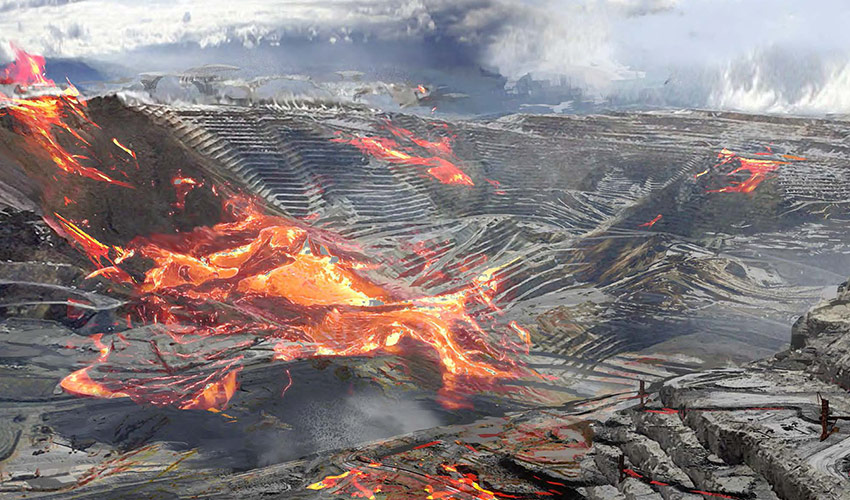
Axgard is marked by three distinct mountain ranges, separated by rocky flatland where hardy golden grasses grow in the warm season. There are few trees, and from the surface, there is little evidence that anyone lives there save the mountain lions, goats, and raptors that make their homes on the barren slopes. But in some places, the sounds of industry can be heard ringing through the air, and on closer inspection, explorers might see a flash of metal, a glimpse of one of eight golden doors built into the mountainsides.
The fabled dwarven City of Eight Doors can be accessed only through these golden doors, and the doors are opened to the surface only in cases of dire emergency. No invaders from this realm or any other have ever breached the city; it is widely considered impregnable. Would-be raiders would have to cross miles of rugged mountains to even reach one of the entrances, and the doors are heavily warded against both magical and physical damage.
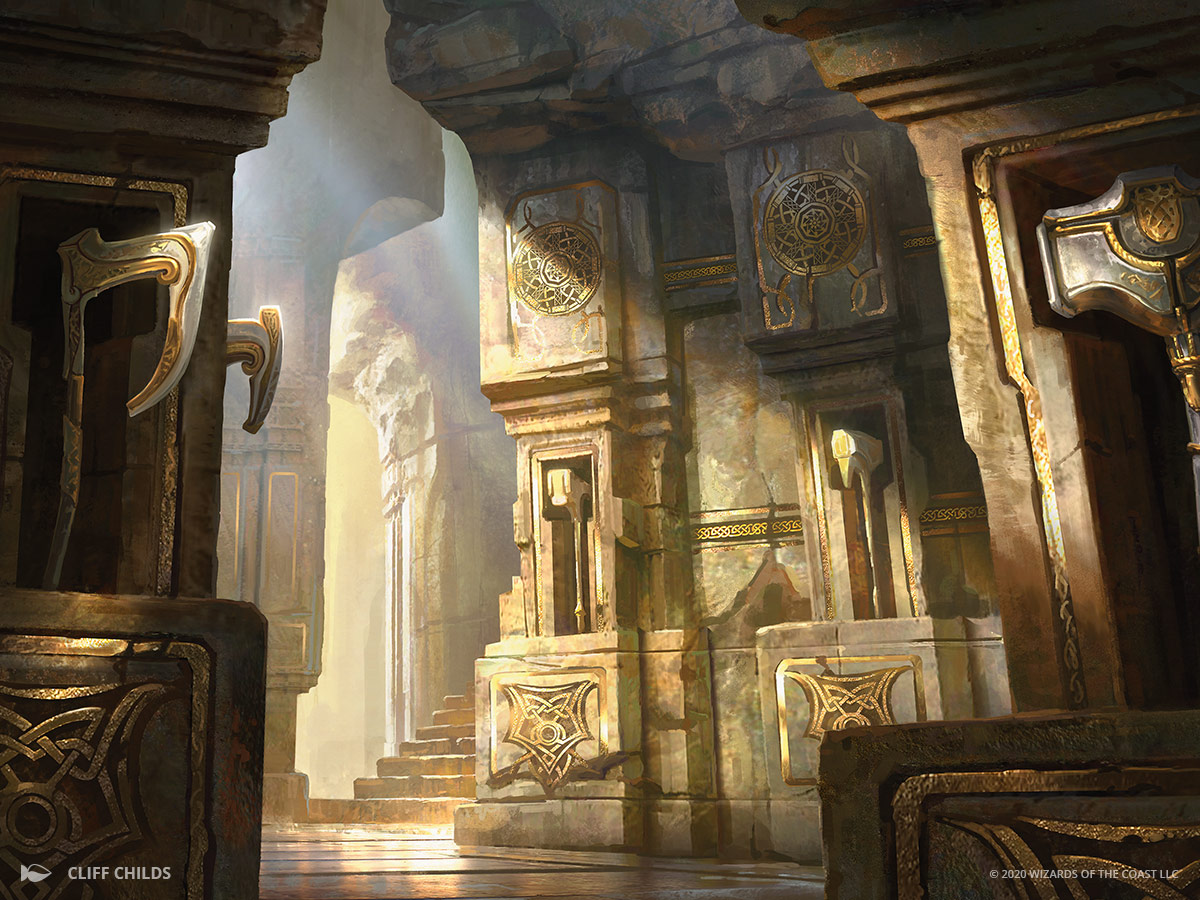
Vast, gilded halls stretch for miles under the mountains and flatlands: feast-halls with long tables, immense rooms filled with exquisitely crafted weapons, and huge auditoriums where thousands of dwarves gather to hear the stories of their people.
The largest of these auditoriums is Bloodhammer Hall, named in honor of the city's founder, Vilnus Bloodhammer. Its domed ceiling is covered in gold, and the walls are painted with scenes from the sagas of every realm, including realms that were destroyed long ago and otherwise forgotten. The dwarves' largest saga-telling competition is held here: skalds recite epic tales for vast audiences of Axgard's most influential citizens, competing to see who tells the best story
The sculpted pillars and walls of the dwarven halls are inlaid with gold that gleams with a soft, warm glow. Drawn from an apparently endless supply of bubbling liquid gold found in the Goldmaw Chasm, far below the city, this gold provides all the light the dwarves need to go about their business in the city. Because gold is so readily available to them, the dwarves do not count it as valuable (their currency is made from iron, which is valued for its utility, not its rarity), but they do find it aesthetically pleasing.
The Dwarves of Axgard
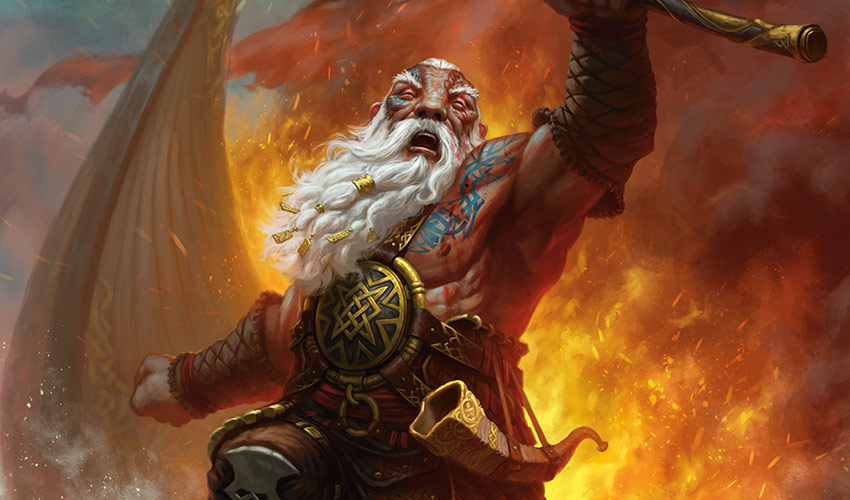
Dwarves are renowned through all the realms for two things: perfect weapons and exquisite storytelling. They are passionately creative, with an insatiable longing to constantly improve their craft. They strive to create the sharpest swords, the most beautiful jewelry, the strongest chains—and then immortalize their deeds in song and story. They seek to build things that last, to make their mark on the world so future generations remember them.
Dwarven society takes the form of sprawling, loose-knit clans that congregate in certain sections of the underground city. Different clans specialize in different crafts, and though they coexist amicably enough, they also have a strong competitive streak that sometimes sets them at odds.
The Arts of War
For dwarves, a warrior and a skilled artisan are one and the same. The art of combat and the art of creation draw from the same principles of focus, patience, and constant self-improvement. Red- and white-aligned dwarves approach these processes differently, but the perfection of their craft is equally important to both.
Red-aligned dwarf warrior-artisans are prone to bursts of wild inspiration and get easily absorbed in their current projects. They produce weapons of staggering raw power—hammers that split the earth where they strike, blazing-hot swords that melt armor with a swing, and javelins that trail searing bolts of lightning behind them.
White-aligned dwarf warrior-artisans are methodical and detailed. They follow disciplined processes and are capable of finer, more nuanced work than their red-aligned kin. Beautiful jewelry, armor that makes the wearer invisible, and chains forged from a wolf's tears are some examples of the handiwork of white-aligned dwarves. They are every bit as precise and meticulous in combat as they are in the forge.
Signature Weapons
Every dwarf artisan spends their youth forging a single weapon and infusing it with runic magic, preparing to carry it for their entire life. These weapons are their creators' pride and joy, and many dwarves design their clothing and armor to match their weapon. On a dwarf's 100th birthday, marking the start of adulthood, they will reveal the weapon and their new last name, chosen based on their great creation. Goldstaff, Hammershine, and Fireshield are some examples of dwarven last names inspired by their bearers' signature weapons.
The Goldeater and the Final Battle
An unfinished saga foretells the near destruction of the City of Eight Doors by the Goldeater, a Cosmos Giant drawn to Axgard by the treasures of the Goldmaw Chasm. Every dwarf warrior carries the prophecy of that final battle in mind throughout their battle training, and it drives them to be the best fighters they can be. Most dwarves imagine that they might be the one to strike the deathblow against the Goldeater and save the city so their name will be written into the final chapter of the saga.
Chanters and Battle Skalds
Skalds (dwarf clerics) hold a special place in dwarven society as the chief storytellers, the repositories of the sagas and fables that remind the dwarves of who they are. Since the dwarves keep no written history, storytellers are the bearers of an intricate oral tradition that has been passed down through countless generations. A skald is welcome in any dwarven community, always treated as an honored guest.
Chanters are skalds whose primary function is to remind the dwarves of the deeds of the past and inspire the dwarves of today to similarly heroic deeds. They tell tales of heroes to help shape new heroes; they tell tales of justice and community to strengthen the bonds of community and the commitment to justice.
Battle skalds earn their title by returning home from battle to tell the story of the battle and its heroes. Their function is to collect tales of present heroism and accomplishment. They are revered across the realms for their bravery and storytelling ability, and they're often enlisted by adventurers or even gods to bear witness to some monumental feat. A saying popular among the human Tuskeri clan claims, "A feat is just a lie unless a skald is there to tell the tale."
GNOTTVOLD
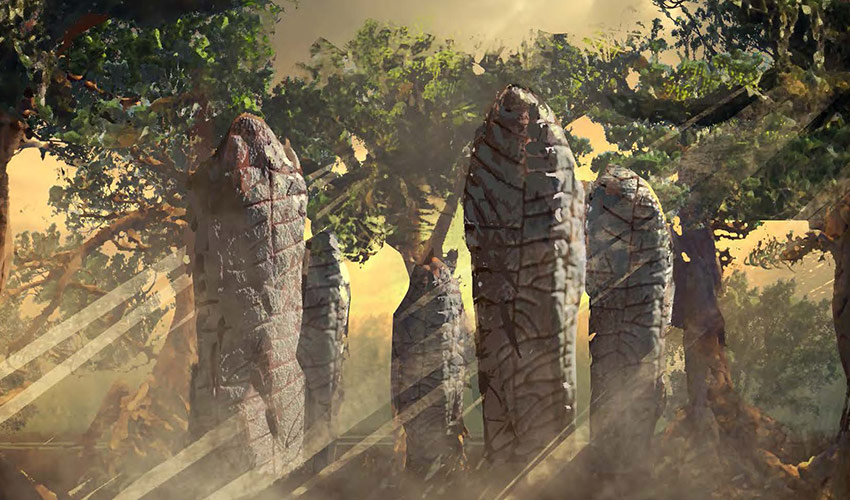
The unspoiled wilds of Gnottvold are marked only by the overgrown ruins of the ancient giants and occasional crude wooden shelters built by trolls. The Hamundar Forest is a dense, primordial wood made up of towering trees and lush undergrowth. In one sacred site deep in the forest, called Karo Glade, a cluster of weathered standing stones is encircled by a ring of the largest, oldest trees in the realm. These stones are believed to predate even the giants' long-lost civilization.
The rocky highlands of Mossrun are littered with boulders and broken ruins, including a number of crude cairns and barrows left by the ancient giants. Atop a high cliff overlooking a vast stretch of forest, the largely intact remains of an ancient fortress called Reynir Hall stand preserved by runic magic from a bygone age. A steep, treacherous path leads up the cliffside to the hall, which provides shelter to a horde of belligerent, hungry trolls—a strong deterrent to any explorer who might think to plunder the ruins for ancient magic.
Trolls
The ancient ruins of Gnottvold provide some degree of shelter to two distinct varieties of troll. The smaller, more aggressive Hagi trolls run wild across the realm, hunting in disorganized packs. They like to harass the larger Torga trolls, who live in family groups and can sleep for years at a time. Despite their apparently somnolent nature, a Torga troll that is unexpectedly awakened from its slumber rises in a rage and sets out on a destructive rampage that can last for weeks until the troll is spent and looks for a new place to sleep.
Hagi Trolls
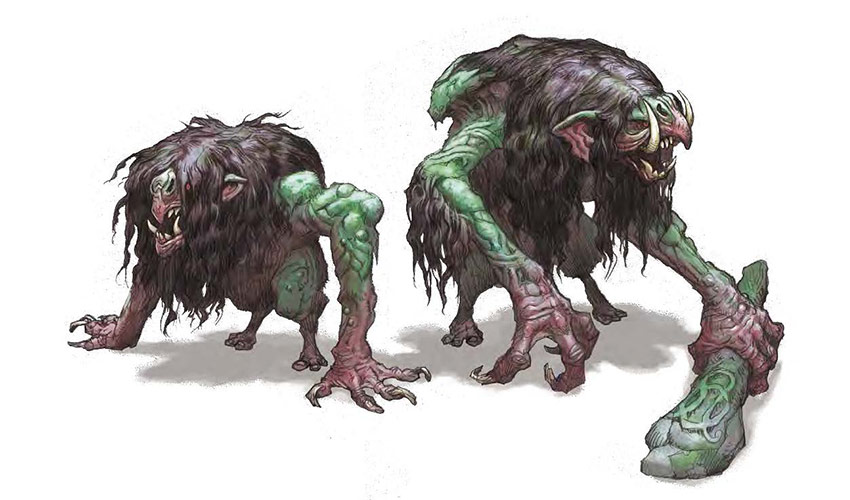
Hagi trolls are both smaller and meaner than the Torga, although some Hagi can grow to impressive sizes. They aren't particularly intelligent, and their motivations are basic and primal: get the most food, have the best lair, find the best stuff. To that end, they travel in loose packs and sleep in crowded warrens, but their foul tempers mean that squabbles and feuds are common.
Over the course of generations, the Hagi have scavenged what they could from many of the old ruins, and they continue to search for unplundered barrows and cairns. They use no form of currency, but shards of swords, rune-stamped metalwork, or broken chalices have become treasured commodities among their clans. Although they don't have a written language of their own, they have deciphered some of the old giants' runes and gradually developed a kind of crude rudimentary magic that they can barely control, which tends to be unexpectedly explosive—the lifespan of a Hagi mage is much shorter than that of other trolls.
Mostly, the Hagi fight hand-to-hand or with pieces of ancient weapons. If they need to raid another Hagi clan or attack a Torga family group that has something they want, they strap a rock onto a stick or fashion some other crude weapon, but their interest in crafts ends there.
Torga Trolls
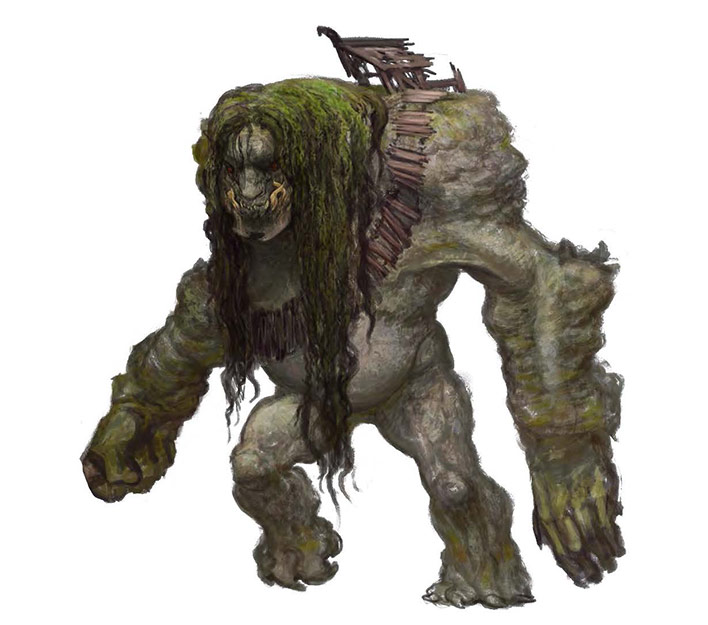
The Torga make their homes in overgrown ruins, particularly in the dense Hamundar Forest. They tend to stay in small family groups, clashing regularly with other groups over territory and food sources. Unlike the Hagi, they are shamanistic and deeply connected to the natural world, many of them skilled with nature and healing magic. Because of this connection to nature, the Torga are incredibly strong and resilient with remarkable regenerative abilities. They are highly protective of the Hamundar Forest and will attack Hagi who venture into it. Repelling outsiders is one of the only things that can motivate different family groups to work together.
The Torga are motivated most strongly by a desire to sleep, and they're very good at it, often sleeping for years at a time. They sleep so long that they blend into their environment—it's easy to mistake a long-sleeping Torga for a boulder or a piece of an old ruin. In fact, some Torga select areas near the giants' ruins as a sort of camouflage for them during their long sleep.
Eventually, plants grow over them until it's hard to tell where the Torga ends and the ruin begins. They loathe being awakened prematurely and become incredibly violent and brutal when their slumber is disturbed. They rampage about in a blind rage, destroying anything in their paths— including ripping Hagi trolls in half with their bare hands—until they are utterly exhausted. Then they go back to sleep.
IMMERSTURM
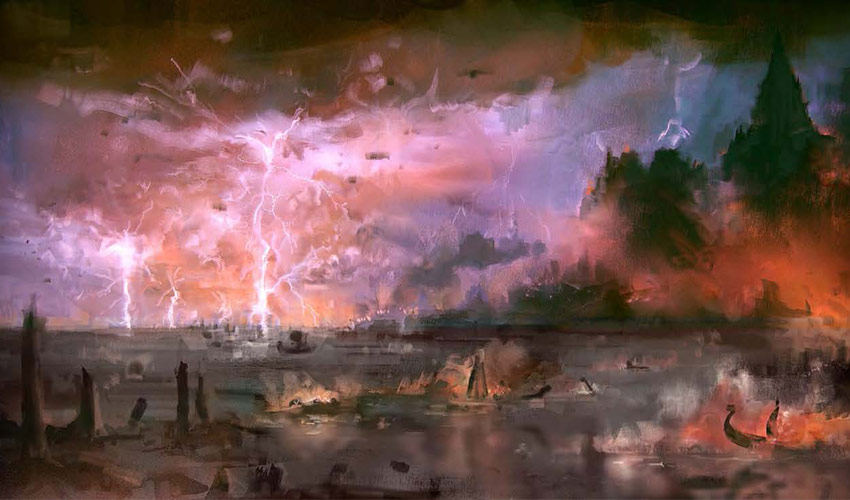
Immersturm is a land of fire, demons, and constant warfare. As lightning crashes in the sky, demonic raiders sail flaming ships across burning seas, scouring the realm for routes into other realms they can pillage. The gods have placed powerful runic wards around Immersturm to keep the demons trapped and prevent them from causing havoc elsewhere, but the wards aren't perfect, and it's only a matter of time until the demons find another way out.
Immersturm never stops burning. The seas are made of fire, and the sky is lit by a perpetual lightning storm. The demons inhabit a bleak, mountainous landmass made of sharp, unforgiving black rock and pitted with burning craters. Noxious fumes, toxic to all but demons, emit from the cracks and billow into the sky. There is no vegetation in Immersturm. The only wild "animals" are beasts formed of elemental flame that spring from pits of fire.
Rival demon jarls come to battle each other on the bloodstained Fields of Elskul. Since the demons can't leave Immersturm, they have only each other to fight, and their insatiable bloodlust means that a massive battle is constantly raging on the black battlefields, day and night. Few combatants have any reason for fighting or any grudge against other demons; they simply battle for the battle's own sake.
The Bloodcrag is a volcano deep in the black mountains of Immersturm. No lava bubbles in its caldera—instead, it seethes with blood, for the Bloodcrag is the source of all demons. Every time a demon slaughters a non-demonic creature (which every demon does at every possible opportunity), the victim's blood is magically transferred to the Bloodcrag. When the seething gore of the demons' conquests reaches the lip of the caldera, a new demon emerges. However, the runic wards that trap the demons in this realm make new victims scarce, and no new demons have emerged from the Bloodcrag in many years.
When demon raiders have managed to plunder other realms, they deposited their spoils in the underground Vaults of Hellir. Artifacts from ancient civilizations and arcane secrets lost for generations have been gathering dust for centuries in the labyrinthine chambers below the burning seas.
Demons
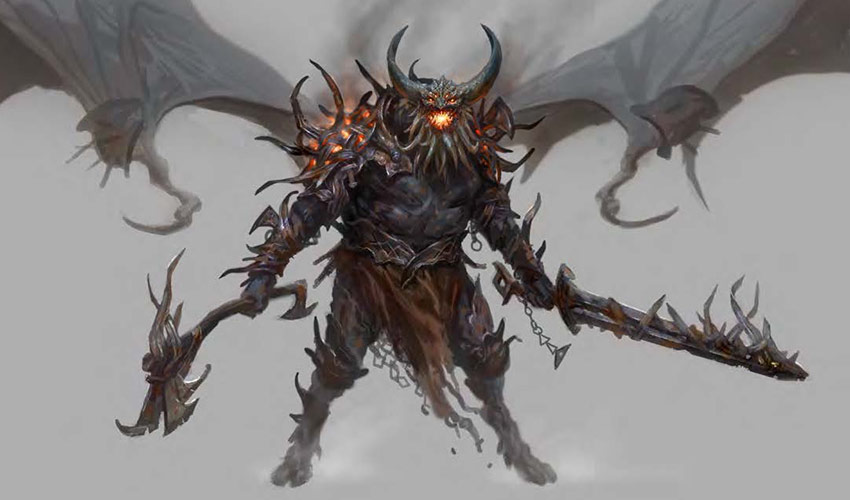
Immersturm's demons are vicious Viking raiders with an unrivaled thirst for destruction. Since the gods laid down the runes that trapped them in the realm, rival demon jarls and their savage legions have been battling constantly, furiously, on the Fields of Elskul. When they're not busy tearing each other apart, the demons search hungrily for any opportunity to raid other realms. Demon society is divided into legions, each led by a powerful leader known as a Slaughtermaster. Black-aligned demons are conquerors who want to spread fear and terror as they claim other realms for themselves. Red-aligned demons are hellbent on destruction and pain and want to burn everything to the ground and slaughter everyone they find.
The Einir (the gods who birthed the elven race) sealed the demons into Immersturm using powerful magical objects of their own design. When the Skoti challenged the Einir's supremacy and defeated them, these relics were lost. The Skoti used runic magic to reseal Immersturm, but they have been less than vigilant about maintaining the safeguards.
ISTFELL
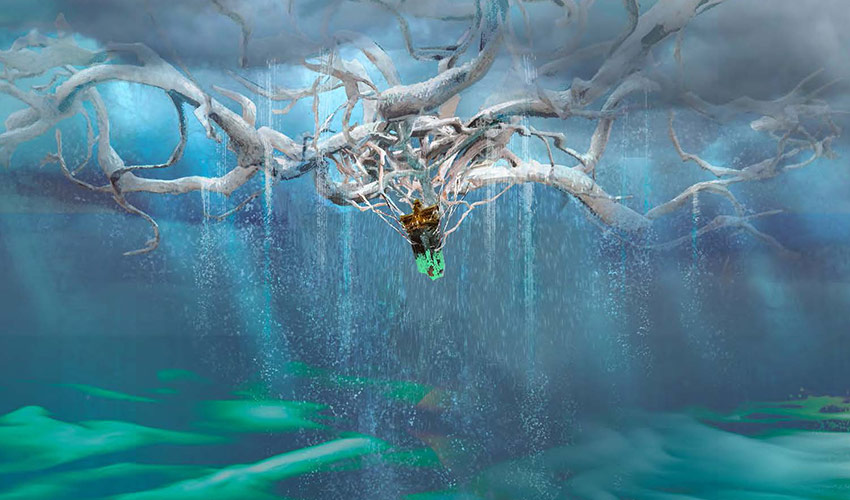
Istfell is the mist-shrouded realm at the base of the World Tree, a vast plain ringed by a fastmoving river and a towering stone wall. The plain is dotted with bottomless wells and white-stone cairns whose origin and significance are lost to the ages. Looming overhead is the unfathomably huge bulk of the World Tree, whose dangling roots plunge into the realm. Occasional aurora light from the Cosmos breaks through the ever-present gloom and dances across the sky, but its brilliance is muted by the unending fog, which grows thicker and thicker toward the center of Istfell. The spirits of animals, monsters, and most people come to Istfell when they die and spend eternity in aimless imitation of mortal life.
The plains of Istfell are encircled by the bone-chilling waters of the Vangir River. Beyond the river is a towering wall, over a hundred feet high, built eons ago to keep Cosmos monsters from attacking the roots of the young World Tree. The only entrance into Istfell is a massive bridge across the river that leads directly to the magnificent Gates of Istfell.
Spirits
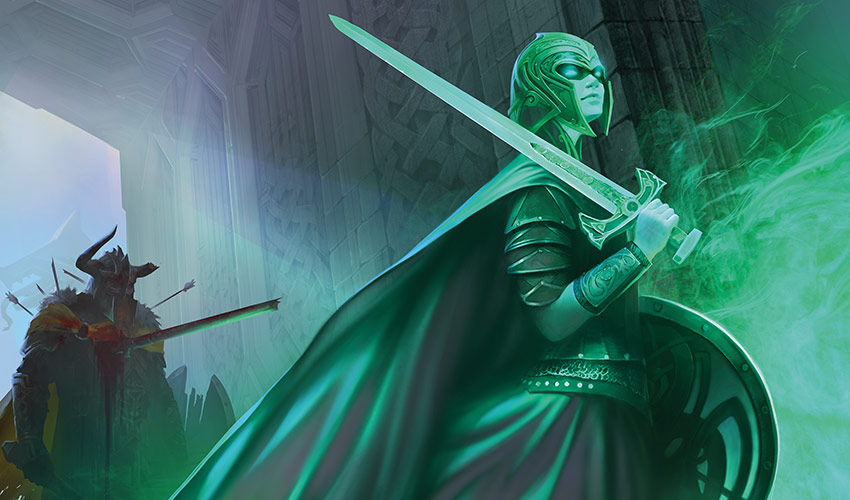
People who die in particularly brave or glorious fashion are marked by the Valkyries and taken to Starnheim. Istfell is for everyone else. The spirits of Istfell include those of people who died of natural causes or accidents, or who showed cowardice in combat. The spirit of every animal or monster that ever lived also runs free in Istfell, and it's not uncommon to see a giant spirit wolf or dragon emerging from the mist.
The spirits who inhabit Istfell resemble whoever or whatever they were in life, but they are wispy, transparent, and grayish or bluish in color, lacking the warm colors of living blood. The longer they linger as spirits, the more they blend into the perpetual mist and foggy background of the realm. When the spirits move together in groups, they form great misty clouds that drift across the landscape, virtually indistinguishable from the constant fog.
Many spirits retain the memories of their lives, but they have lost all passion and, with it, the motivation to fight or form relationships. Rather, they simply move aimlessly in groups, drifting like the fog across the fields and along the rivers. With the aid of powerful magic, it is possible to rouse them to anger or convince them to fight. Many spirits vaguely accept that Egon, the god of death, is the ruler of that land, but even he must use his own god-magic to get them to perform tasks or fight for him.
The Gods' Hall

The only other structure in Istfell is the magnificent Gods' Hall, which is a new addition to the realm. How it got there is a saga unto itself.
The Hall of the Skoti had stood for generations in the Gods' Realm. One day, Toralf and Halvar were sparring when Valki appeared, struggling under the weight of a godstone harness that had been fashioned by the dwarves. When Toralf asked his brother what troubled him, Valki threw down the harness in frustration. He told Toralf and Halvar that he had captured the spirit horse Windfell, a feat that many had attempted in the past but no one had accomplished. His brothers began to praise him loudly, but he waved dismissively, because the feat was incomplete. Valki had managed to bring Windfell to the Gods' Realm, but to tame him, he must put the rune-enchanted harness around the horse's neck. And that, Valki whined, was impossible.
At the word "impossible," Toralf stood taller. Nothing was impossible for the strongest son of the Skoti. Halvar whispered a warning in Toralf's ear that this could be a trick (Valki was known for his tricks), but Toralf never listened to Halvar, even though Halvar was always the most sensible person in any room. Toralf effortlessly picked up the harness, and the three gods left the Hall. In the courtyard, they stood in awe of Windfell, the wild spirit horse who tossed his head at the indignity of being trapped behind walls of any kind. As Toralf approached the horse with the harness, Windfell stamped his feet, pranced around the god, and sped toward the gate. The horse leapt over the gate and, faster than the storms of Karfell, raced away from the Hall of the Skoti.
For three days, Toralf pursued Windfell as the wild horse ran back to the realm of the spirits, finally catching up with him just inside the Gates of Istfell. With great effort, Toralf hefted the harness onto the horse. Suddenly, there was a blinding flash of light and a resounding thunder that could be heard in all the realms. Toralf was blasted backwards into the Gates of Istfell with such force that a pillar cracked. When Toralf opened his eyes, Valki's trick was revealed. The harness was tethered to the Gods' Hall, and Toralf's mighty strength had triggered the runic magic, which pulled the Hall all the way from the Gods' Realm to the bottom of the World Tree, where it became lodged in the roots. The rest of the gods emerged from the Hall, scratching their heads as they surveyed the endless ranks of spirits staring up at them. Valki was nowhere to be found.
— The Saga of Valki's Deceit
The gods keep saying they should move it back to the Gods' Realm, but some sort of magic seeping out from the World Tree has so far hindered their halfhearted efforts, and no one has decided to make it a priority.
KARFELL

Frigid seas lash against glacier-covered shores in the harsh realm of Karfell. Long ago, this realm was ruled by dynasties of High Kings and Queens in a contorted web of alliances, vassal states, and mighty fortresses, but only the shadows of those glory days remain. Now, the fortresses are crumbling and half-buried in snow, and almost all the realm's current inhabitants are undead. These zombies, known as draugr, retain the intelligence and memories they had in life, and they give their allegiance to Narfi, the Last High King of Karfell.
Karfell was once a land ruled by wealthy nobles who dwelled in formidable fortresses, all of which have fallen into a state of snow-crusted ruin. Despite its misfortunes, Karfell's great wealth is legendary throughout the realms. Many raiders brave the harsh conditions in hopes of finding the old rulers' extravagant treasures, rumored to be hidden under the ice or inside ancient glaciers.
The lich-king Narfi still rules from the Port of Marn, the greatest of the old cities, and holds court with his undead nobles while a frigid wind blows through cracks in the stones. The massive, fortified port is protected from the lashing tides by a towering seawall, known as the Haunted Edge for the thousands of skeletons entombed inside it.
King Narfi maintains an army of raiders known as the Dead Marn. Whenever a Doomskar or Omenpath presents the opportunity, the Dead Marn pillage other realms in search of more treasure to add to Karfell's already packed treasure vaults.
Skybreen Mountains
The inland heights of the Skybreen Mountains are a brutal habitat for Karfell's few living human inhabitants—barbarians who scratch out a living in the harshest of conditions. They live in a state of constant warfare with each other (and occasionally, disastrously, with the draugr) and are homicidally suspicious of outsiders.
Brinebarrow
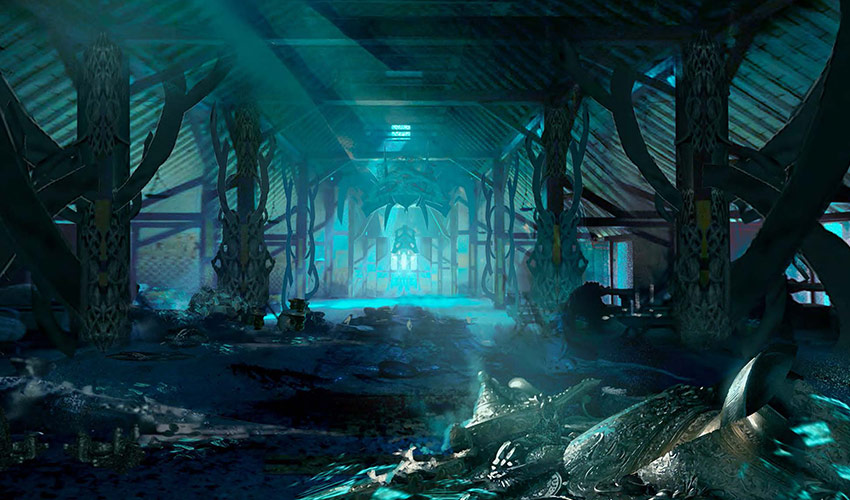
The treasure vaults of ancient Brinebarrow are said to be so fabulous, they have become a byword for great wealth throughout the realms. Yet, curiously, no raider has ever returned with more than a few coins from this hoard. Most who seek Brinebarrow don't return at all. The rest come home with tales of incredible treasure hoards, but they might describe the jeweled goblets they stole and then display nothing more than tarnished old cups.
Draugr
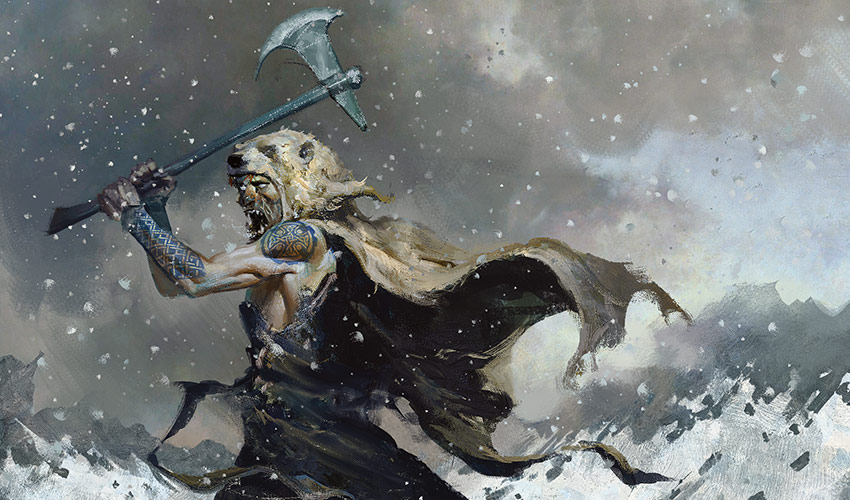
The draugr are an ancient race of undead lords and their subjects, animated by their pathological lust for wealth and power. The draugr jealously guard their vaults against intruders who come to Karfell seeking the ancient treasures and powerful magic items the draugr have stockpiled. Occasionally, the undead venture forth in their strange stone ships to raid other realms and bring back yet more wealth to add to their overflowing vaults.
Generations ago, King Narfi betrayed his people and led the god of death to transform all Karfell's nobles and their subjects into undead. They retain some or all memories and intelligence they had in life, and in death, they are motivated by the same desire for wealth and power that drove them before. The ancient nobles remember the time when the elves possessed godlike power, and they witnessed the huge battle that led to the downfall of the elves and the rise of the Skoti. Their undead subjects retain fewer memories of their existence and now mindlessly serve their lords.
The draugr maintain the noble houses and strict class hierarchy that was established when Karfell was a living kingdom. The warrior class, known as the Dead Marn, patrol in half-remembered echoes of their old sentry routes, while draugr jarls stir only every few months to attend council meetings with King Narfi. When a Doomskar brings Karfell into contact with another realm, the Dead Marn prefer to launch raids on other realms by sea, but occasionally march to war in silent ranks of undead warriors.
LITTJARA
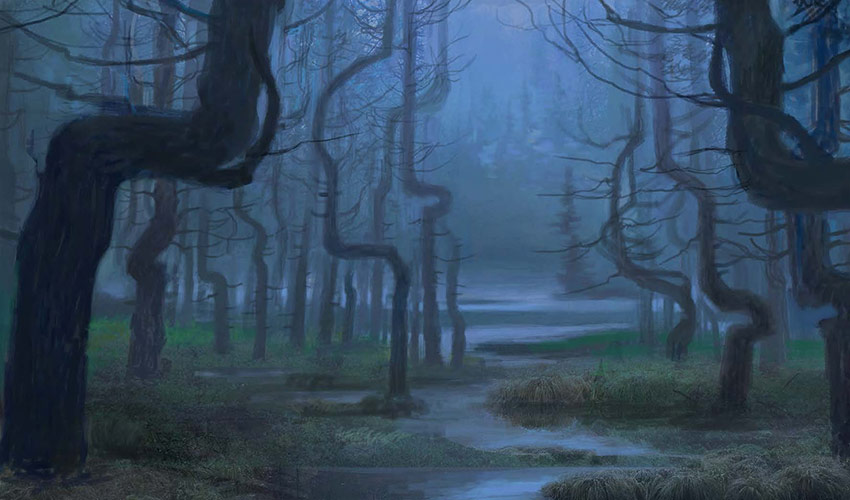
Littjara is a mysterious realm of lakes and pine forests where reality seems as mutable as the shapeshifters who dwell there. Trunks of trees change direction abruptly, the surface of a lake curves upward into a bowl, aquatic plants grow naturally into unexpected patterns. Visitors might see the smoke of a campfire wafting into the air but arrive at the spot only to find a fawn lying in the grass with no campsite to be seen.
Littjara is a strangely mutable realm, as cryptic and secretive as the shapeshifters who dwell there. Even at midday, only a dim ambient radiance lights the landscape and odd-shaped plants cast twisting shadows in every direction.
The barriers that divide the realm from the Cosmos are far thinner than they are in any other realm, making it easy to enter—but the strangeness of the realm is disorienting, making it not so easy to leave. The shapeshifters themselves can pass easily out of Littjara and into the Cosmos, but outsiders who visit the realm find themselves helplessly lost, and those who make it back out are rarely eager to return.
Pentafjord Lake
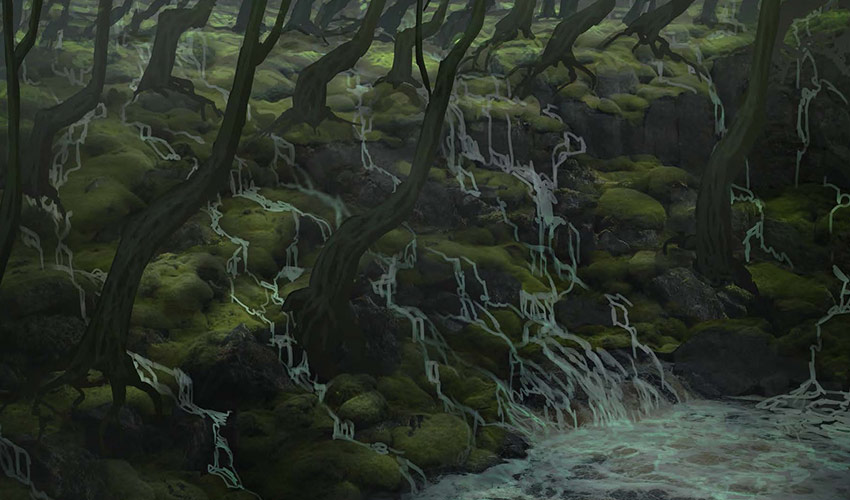
When the Einir, the ancient elven gods, created the realm that would become Littjara, their interference marked the land indelibly. An enormous depression—miles wide, shaped like a hand, and full of fresh, clear water—is one of the few parts of Littjara that always remains the same. Faint prismatic lights, echoes of the Cosmos aurora, dance beneath the water's surface.
At the end of their lives, all shapeshifters are drawn to return to Littjara, where they make their way to the Pentafjord and slip beneath its surface to pass away.
Shapeshifters
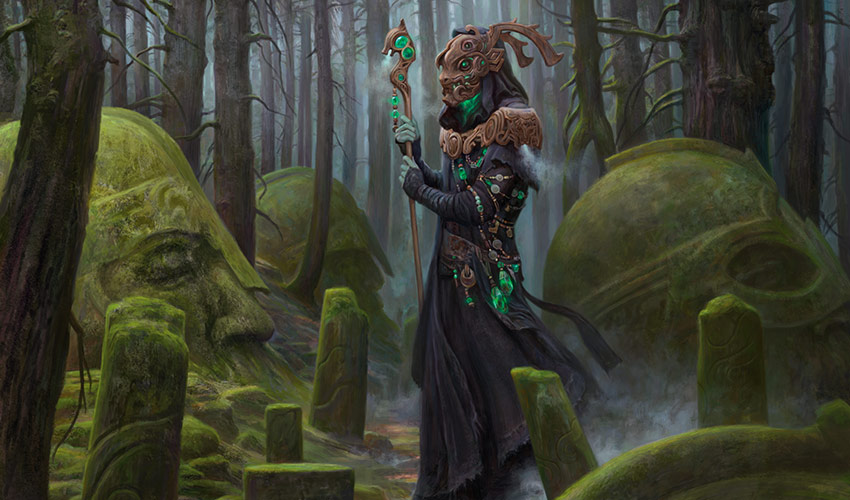
The shapeshifters of Littjara are mysterious, masked beings with the ability to change their physical form at will. They wear beautifully carved masks and heavy traveling cloaks to obscure their true faces and forms, which are unknown to any but the shapeshifters themselves. They can take any form necessary to blend into their surroundings—including a shifting aurora form that enables them to move freely through the Cosmos—but they tend to prefer animal forms.
Gladewalkers and Covewalkers
Shapeshifters are green- or blue-aligned. A shapeshifter aligned with either color can take any form, but they tend to prefer different shapes, in part depending on their color. Green-aligned shapeshifters, known as Gladewalkers, prefer the forms of wild beasts over any humanoid identity. Bears are a favorite form, but any stag, lynx, bird, or squirrel spotted in the woodlands could be a Gladewalker in disguise. Covewalkers, the blue-aligned shapeshifters, are fascinated with water. They often take on the form of marine animals such as seals or dolphins. They also frequently adopt the identities of mariners, seafaring raiders, fishers, lighthouse keepers, and other humanoids who dwell on or near the waters.
Shapeshifters appear frequently in sagas as villains or tricksters, creating trouble for local humanoids and confounding the efforts of heroes. This portrayal reflects the deep-seated mistrust that many humanoids harbor for them but doesn't necessarily reflect the truth of their interactions with other races. In truth, shapeshifters can live for years undetected among other peoples, indulging an endless curiosity into the ways of the realms.
If they have other motivations beyond curiosity, they are kept secret from other races—as are their true forms.
Walking the Realms
Many believe that shapeshifters are formed from the same stuff as the Cosmos itself—pure shifting light and celestial energy. Whether or not that is their true nature, they can adopt a form similar to the auroras of the Cosmos in order to travel between realms, even in the absence of an Omenpath or Doomskar.
Given this ability to move among the realms, shapeshifters readily make use of it. Curious and adaptable, they often spend only the few years of a brief childhood in Littjara before venturing out into the Cosmos to see and learn about other realms. Many shapeshifters spend almost their entire lives among other races, until at last they return to Littjara for the last years of their lives and end their existence submerged and subsumed into Pentafjord Lake.
The Secrets of Littjara
An ancient saga tells the story of the shapeshifters' origin. As the story goes, they were once people of an unknown race living in a small village in a long-forgotten realm. Under the thumb of a tyrannical jarl, these people prayed to the Einir (the ancient elven gods) to spare their youths from being conscripted into their jarl's unjust war. The Einir granted their prayer, giving them the ability to change their form. The youths were disguised as elderly people and ordinary animals, leaving no one fit to serve in the jarl's armies. Enraged, the jarl ordered the slaughter of the entire town, and the villagers fled for their lives.
As the jarl's legions pursued the fleeing villagers, the Einir saw their plight and created a safe place for them. They pulled away a fragment of their own realm, intending to wall it off with steep mountains to create an impenetrable sanctuary. But their chaotic magic created an unstable and half-formed world, where smooth cliffs rise at unnaturally precise angles, trees are crowned with roots and supported by branches reaching into the ground, and a giant handprint in the landscape is now a lake with crystal waters.
The people who settled in this new land took on its shifting characteristics; over the generations, they left their original race behind and became the shapeshifters. Now land and people alike are mutable, cryptic, and secretive.
SKEMFAR
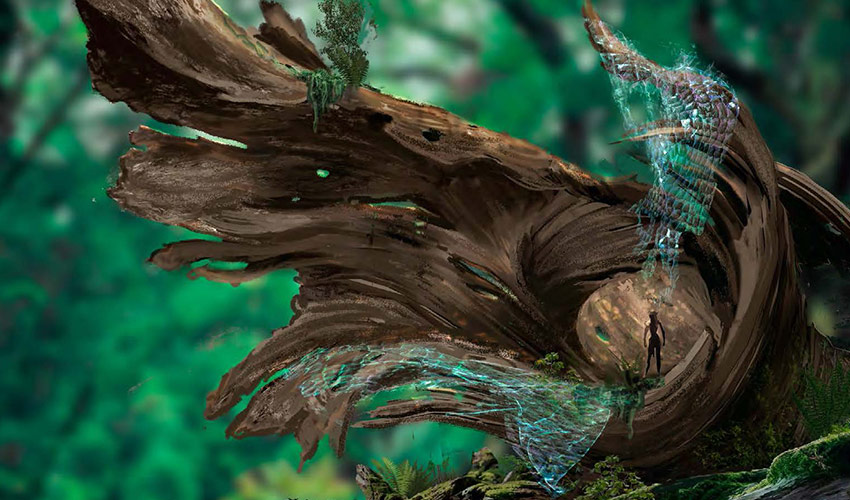
Skemfar is a shadowy realm where towering trees block any view of the sky and vast peat bogs hide the remnants of ancient battles among the gods. Seven massive trees hold the losers of those battles forever bound, and their ancient halls now provide homes for their distant descendants, the elves. Tunnels bored by the great Cosmos Serpent wind through the ground. The air is redolent with the smells of life and decay, and the weight of uncounted ages hangs heavy.
At first blush, Skemfar looks like a vast expanse of unspoiled wilderness, untouched by any sentient hand since the beginning of time. In truth, elvish settlements are dotted across the landscape. Some are hidden underground or carved into gnarled roots, and others are graceful buildings seamlessly grown into the living branches overhead. A few of these settlements—where the wood elves and shadow elves live together, reunited under their new king—include both branch-lifted and root-sunk dwellings, reflecting the elves' intertwined destinies.
The largest elf settlement is Jormund, an ancient city built when the elves were gods. Its architecture is ornate and ceremonial, bearing little resemblance to the more recent constructions of either race of elves. Magic pervades the place, limning the branches with faerie glow in the perpetual twilight under the trees' high branches. At the heart of the city is Harthhall, the newly built home of the king of the elves.
Jaspera Trees

Seven towering trees scattered across Skemfar's wide forests are said to be prisons where the Skoti imprisoned the surviving leaders of the Einir, setting them as a warning of what happens to those who challenge their divine authority. The entombed Einir are now one with the trees that bind them, and the elves revere the trees as if they were their ancient leaders. Each of the trees has unique magical properties based on the god imprisoned within: one produces fruit that can heal any illness and close any wound, another produces wood that can't be cut or broken (except when the god inside decides to give a branch to a worthy supplicant). Harald, king of the elves, claims to have received a vision of a united elf dynasty when he ate the fruit of a Jaspera tree and slept beneath its boughs.
Serpent Tunnels
The elves revere Koma, the Cosmos Serpent. In ancient times, they say, the serpent roamed freely and drank deeply from the ancient arcane energy of Skemfar. He left a vast network of tunnels in his wake, and both wood and shadow elves consider these passageways to be sacred spaces. The elves tend the tunnels faithfully, believing that the Cosmos Serpent will one day use them to return to Skemfar—for the gods of the current age, the Skoti, have forbade him from entering any of the realms. The elves are almost as angry about this as they are about the Skoti defeating the Einir, the elves' divine ancestors.
Elves
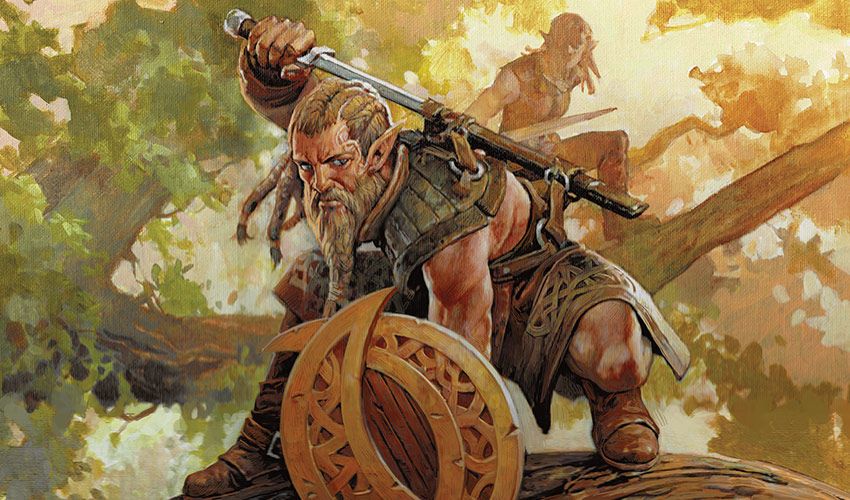
United in an uneasy alliance under a single king for the first time in generations, wood elves and shadow elves continue their struggle to regain their former power amid the primordial forests and vast mires of Skemfar. For all their differences, both factions of elves share a common reverence for the Cosmos Serpent and a common hope that they will one day restore themselves as the gods of Kaldheim.
The Downfall of the Einir
An ancient saga tells the tale of the Einir's battle against the upstart would-be gods, the Skoti. The Skoti triumphed, thanks in part to the dwarf-crafted axe Galdrimel, which Halvar wielded to devastating effect against the Einir. The axe could sever any substance, even the Cosmos, and Halvar used it to split the elf race in half, creating the wood elves and the shadow elves. The Skoti also banished the Cosmos Serpent, which the Einir had revered, so it could no longer enter the realms. Robbed of their divine powers, the fallen Einir—the elves—fell to squabbling and vicious infighting.
When the Einir were defeated, Alrund took their seven surviving leaders and imprisoned them within seven great trees across their realm, which are now known as the Jaspera trees.
The Elf-King

After generations of fighting between the wood elves and shadow elves, the descendants of the Einir have now been united again. A wood elf named Harald, after eating the fruit of a Jaspera tree and sleeping beneath its boughs, had a vision foretelling the rise of a great elven dynasty that would unite all elves under a single banner. Harald became convinced that it was his destiny to bring this vision into reality. After long years of struggle, wood and shadow elves are joined together at last, though their unity is tenuous. Harald, called the Elder, proclaimed himself king of the elves, ruler over all Skemfar. Some elves believe the Einir imprisoned in the Jaspera tree is guiding Harald's actions. Some even claim that Harald is possessed by the spirit of this ancient elf god. Among those who believe such things, opinions are divided as to whether the involvement of this Einir spirit bodes good or ill for the destiny of the elves.
Under Harald's leadership, the elves are held together by a shared desire to reclaim the power of the Einir and what they believe to be their rightful place as rulers of all the realms. Despite this shared goal, though, old antagonism still simmers just beneath the surface, and it seems clear that Harald is the only tie that truly binds the two elf factions together. If he dies, the shadow elves and wood elves will almost certainly split once more and resume their ancient war.
STARNHEIM
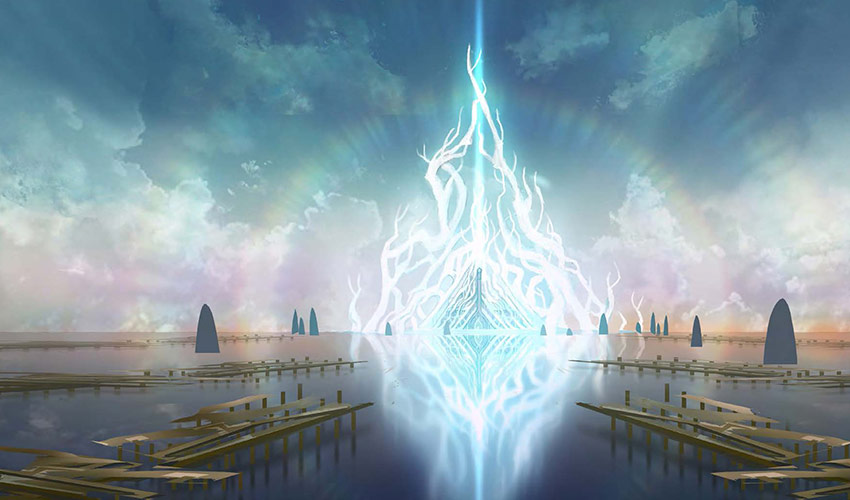
The lofty realm at the top of the World Tree is Starnheim, home of the Valkyries and the honored dead. Carved longships drift silently across a glassy black lake until they reach the central structure: the cavernous Hall of the Valkyries, woven from the living branches of the World Tree. A mystical glyph, the Light of Starnheim, shines overhead like the sun at its zenith and sends its light cascading down the World Tree to every realm.
Hall of the Valkyries
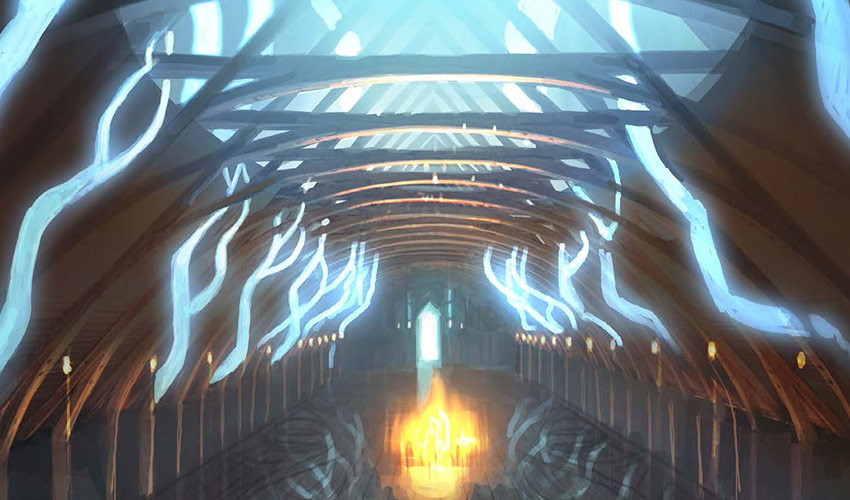
Ancient, elaborate, and pulsing with magic, the longhall at the heart of Starnheim is awe-inspiring. Woven from the uppermost branches of the World Tree where they rise from the lake, the hall seems to float on the surface. Inside, roiling clouds form the ceiling, changing from white to gray to thunderous black depending on the amount of conflict in the lower realms. The vast hall is expansive enough for every worthy person who ever lived to sit at the long table and partake in the eternal feast; however many new souls arrive, the building never feels full and the mead never runs dry.
The Valkyries choose the heroes who will spend eternity, after their mortal lives have ended, feasting forever in the mighty hall. Only the bravest souls, those who perform epic feats and die courageously in battle, can earn such a place of honor.
Everyone who is welcomed into the Hall of the Valkyries is granted the gift of storytelling, so sagas are told at all hours at the eternal feast. Each mortal soul has the opportunity to tell and celebrate the great victories of their lives. These tales are always heroic and sometimes bitterly tragic, but the strong emotions they evoke quickly pass. In the glories of Starnheim, there is no room for sorrow.
Valkmir and the Yetta Docks

The smooth, flat surface of the realm appears to be a glassy black lake, but in fact, the "water" is not water at all. The First Saga calls it Valkmir, the blood of the first Valkyrie who died during the creation of the world. From this lake, all Valkyries were birthed. Depending on who wields it, the powerful magic of Valkmir can heal or destroy.
A network of wooden docks surrounds the Hall of the Valkyries, decorated with carvings of the Cosmos monsters. Twelve longships drift near the docks, one for each of the Skoti, the current reigning gods. For all their lofty status, even the gods are not guaranteed a place in the eternal feast when their end comes. Certain ancient sagas say that unworthy gods will be cast adrift on these boats when they reach Starnheim, sent off into the Cosmos to leave room for worthier gods.
Valkyries
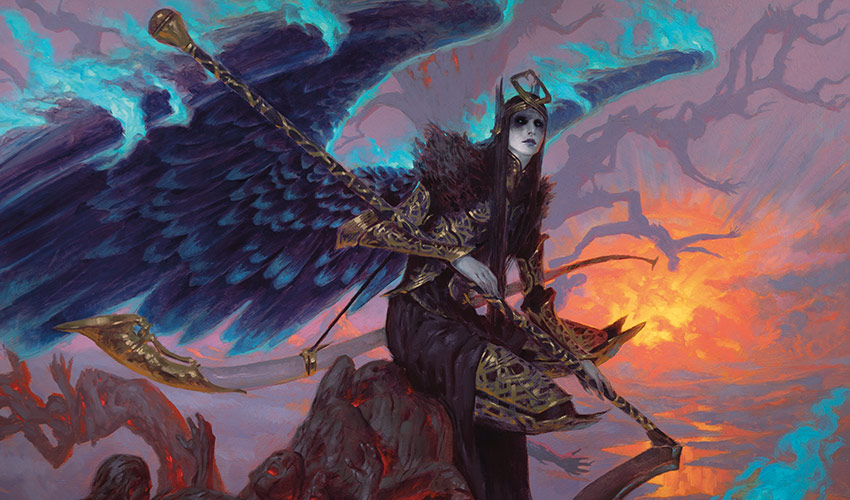
Valkyries are the winged battle angels who select the worthy dead to spend eternity feasting in their great hall in Starnheim. Older than the Skoti, the Valkyries do not serve the gods. They were formed at the beginning of time, and they do not allow their judgment to be clouded by the banal relationships, family ties, and petty squabbling that practically define the nature of the gods. This judgment is their primary purpose, though sagas describe how they occasionally enter into battle themselves for a worthy cause.
Valkyries carry out their missions of judgment in pairs, with a white-aligned shepherd and a black-aligned reaper traveling together.
Shepherds: White-aligned Valkyries are shepherds of the worthy dead. If someone dies with courage and honor—whether in battle or not—a shepherd appears to lead them up to Starnheim and offer them a seat in the Hall of the Valkyries.
Reapers: Black-aligned Valkyries are reapers of the cowardly. While a shepherd will wait for the death of a worthy person, reapers intervene when they witness cowardly deeds. Often, they will simply smite the coward and escort them to the Gates of Istfell, branding them with a rune that announces their shame to all.
Both Valkyries in a pair must agree on each fallen warrior's fate before it can be enacted. Usually, these judgments are straightforward and there is no disagreement—both sides desire a fair fate and care little for "winning" a particular soul. But occasionally, a shepherd must keep a reaper from killing a coward too quickly if the shepherd thinks the person still has a chance at redemption through a courageous act later.
Those who are chosen to enter the Hall of the Valkyries are escorted across the Cosmos on a Prismatic Path, like a rainbow bridge, that flows from a Valkyrie's wings.
Angels of the Battlefield
Some sagas describe the Valkyries joining forces with the gods in some worthy battle, perhaps to slaughter a rampaging Cosmos monster, but rare indeed are the circumstances that draw Valkyries into the heat of battle. On rare occasions, Valkyries judge an entire village or clan unworthy to live, and shepherds and reapers descend together to send the whole cowardly population to Istfell.
On the other hand, Valkyries readily fly to battle against demons. Demons are abhorrently unworthy by their nature, and demons who escape from Immersturm are a threat and must be dealt with speedily. Shepherds and reapers quickly join forces to kill a demon or force it back to its home realm.
SURTLAND
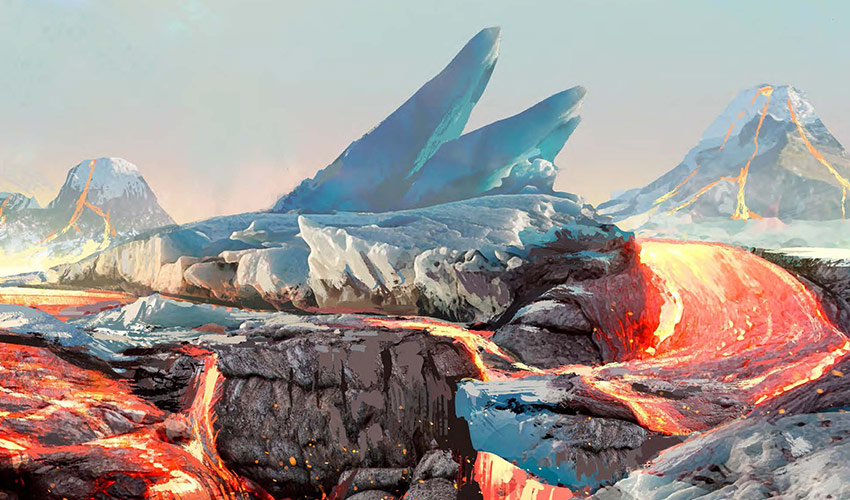
Wintry Surtland is a realm of constant turmoil. Volcanoes burst through snow and ice to form new mountains as the bitter cold freezes steaming geysers into sprays of ice shards. Earthquakes and eruptions reshape the landscape almost daily. Avalanches of snow and broken rock tumble down mountainsides and change the course of half-frozen rivers. The ice palaces of the frost giants dot the high mountain peaks and glacier fields. The crude shelters of the fire giants lie in the lowlands where deep lava fissures carve paths through wide fields of snow.
What little grows in Surtland grows to enormous size. Trees are scarce, but they grow as large as the ancient trees of Skemfar. The beams of Kaldar's Hall, home of the fire giant king, are cut from these enormous trees to make a shelter worthy of the massive giants. Animals, too, tend toward great size; herds of mammoths and giant goats provide much of the giants' food.
Surtland's terrain is so changeable that few features last long enough to be named. One notable exception is the Vela Heights, a series of mountain peaks and glacier fields where a group of frost giant wizards, ordinarily solitary beings, have formed something akin to a community. The Vela giants join their magical powers to create defenses that ensure no fire giant ever enters their Heights.
Giants
Two kinds of giants inhabit the tempestuous realm of Surtland. Frost giants are intelligent and secretive, using runic magic to divine the secrets of the Cosmos and jealously guarding them from the curiosity of outsiders. Fire giants, by contrast, are brutal and impulsive, sharing their kin's physical strength and resilience but lacking any of the frost giants' knowledge and resources. The frost giants control the high ground, claiming all the most stable mountain areas, where they shape fortresses out of ice. Relegated to the lowlands, the fire giants are loath to build anything too permanent, as it's likely to be knocked over or covered in an avalanche or lava flow. They prefer crude wooden longhouses that can be disassembled and moved elsewhere if necessary. The two kinds of giants fight constantly.
The frost and fire giants of Surtland are locked in constant conflict. The frost giants would prefer to be left alone, but they also claim the best, safest territories in the realm—and hoard treasures and arcane secrets for themselves in their mountain palaces. The angry, impulsive fire giants gather in bands to attack the largely solitary frost giants. Frost giants retaliate with blasts of runic ice magic that can scatter or incapacitate a whole fire giant clan.
On very rare occasions, if Surtland is threatened by invaders or a rampaging Cosmos Monster, frost and fire giants are able to put aside their differences and join together to defend their realm.
Frost Giants
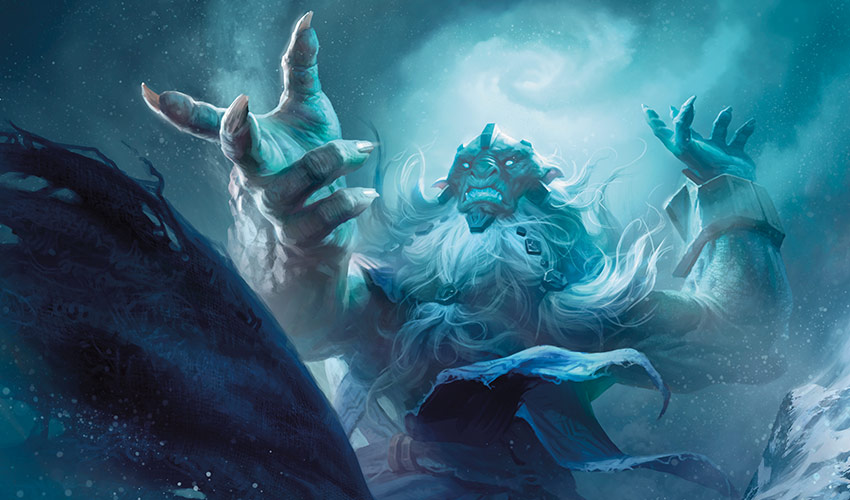
The frost giants claim the high mountain peaks and glacier fields of Surtland where they build ice palaces and spend eons in solitude. Their impregnable mountaintop fortresses afford them clear views of the lights of the Cosmos and their mystical secrets. They rarely leave Surtland and have no interest in raiding, but they have a special relationship with the similar-minded Omenseekers of Bretagard, who sail to Surtland occasionally to trade information with friendly frost giants.
Frost giant wizards called Vela Mages dwell primarily in the well-protected Vela Heights. In addition to manipulating cold and ice with their magic, Vela Mages are seers who work constantly to divine the secrets of the realms. They can use illusion magic to trick unwelcome intruders into their private sanctums, but most of them consider this a lesser form of magic that is not worthy of serious practice unless absolutely necessary.
Fire Giants
Fire giants dwell in the lower elevations of Surtland where snow fields are divided by deep lava fissures. They live together in families and clans, building crude wooden structures from the realm's massive trees. Some also make their lairs in extensive cavern networks and lava tubes that run beneath the lowlands.
Fire giants are reckless, jealous, and competitive—like colossal children who are jealous of their kindred's secret knowledge but unable to grasp it for themselves. They're smaller than frost giants, but they're still giants, and are incredibly tough, strong, and resilient. Countless sagas speak at length about how hard it is to kill a fire giant, and those heroes who succeed at this monumental task are enshrined in legend.
Whenever a Doomskar brings Surtland into contact with another realm, fire giants are eager to launch raids. They love hand-to-hand combat, but they're not above throwing boulders at their enemies, and their wizards have power over fire and lava.
Kaldar is King of the Fire Giants. He and Alrund have a longstanding rivalry and have tricked each other on many occasions. Kaldar views Alrund as everything he envies and detests about the frost giants—their confusing mysticism, their arrogance—elevated to godhood and would like nothing more than to fool him so humiliatingly that he renounces his divine status.
THE SAGA IS ONLY BEGINNING
That is everything you need to know about the realms of Kaldheim. If you're still hungry for more knowledge (Alrund would be proud), keep an eye on DailyMTG over the coming weeks! May your name ring throughout Starnheim!
WORLDBUILDING CREDITS
Again, a very special thanks to everyone who made the creation of Kaldheim possible.
Concept Artists
Alix Branwyn
Chris Rahn
Daarken
Jehan Choo
Jenn Ravenna
Jonas De Ro
Nick Southam
Randy Vargas
Sam Burley
Steve Prescott
Rebecca On
Taylor Ingvarsson
Tyler Jacobson
Viktor Titov
Zack Stella
Worldbuilding Writing Team
Jenna Helland
Ethan Fleischer
Emily Teng
James Wyatt
Annie Sardelis
Hans Ziegler
Doug Beyer
Katie Allison
Art Director
Cynthia Sheppard
Creative Producer
Meris Mullaley
Creative Lead
Jenna Helland
Creative Director
Jess Lanzillo

